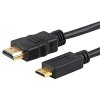I guess I am late to the topic and see that a standard cable can be had, but since the number of wires was asked about, I wish to point out that great care must be taken when considering work with HDMI cables, as in soldering a free end to a board. Splicing two cables is generally not done.
For the purpose of the goggles and a 10 FT cable, even the oldest, lowest specification HDMI cable or any DVI cable with the right connectors will work.
I spent some time in the manufacturers' end of the professional video industry.
Some HDMI info that may be worth knowing:
An HDMI cable is composed of four shielded twisted pairs of wire, with an impedance of 100 Ohms, plus seven additional separate wire conductors. In the '+ ethernet' versions, which do not concern FPV users, the wiring has a slightly different arrangement.
A low voltage differential RF signal is used to transport the data.
Because the signal is RF, splicing is to be avoided and all connections must be completed so that each wire is virtually the same length to avoid degredation of data (skew, timing, phase, common-mode related errors). For this reason no one splices the cables except in an emergency. It does not always work right.
The performance of HDMI cables is limited by the quality and length. 13-15 meters is the generally accepted maximum length at which performance can be certified. A lower quality cable can sometimes work at higher signal rates if it is short.
Each increasing spec of the cable is backward compatible and contains all of the advantages of the lower types.
There are a few HDMI certifications or specs to look for on the packages:
HDMI 1.0:
165MHz clock - 4.95GB/s bandwidth. -same as DVI. - 1920x1080 - 1920x1200
HDMI 1.1:
as above plus supports DVD-audio as well.
HDMI 1.2:
as above plus supports 'One-Bit-Audio" as used on Super Audio CDs.
Supported 720P at 100 and 120Hz.
Certified as agnostic toward specific data formats but rather certified for bandwidth, noise/EMI.
HDMI 1.3:
Category 1 - 74.5MHz - 720p60 and 1080i60 "Standard" cable
Category 2 - 340 MHz - 1080p60 and 2160p30 "High Speed" cable
HDMI 1.4:
Standard HDMI Cable – up to 1080i and 720p
Standard HDMI Cable with Ethernet
Standard Automotive HDMI Cable
High Speed HDMI Cable – 1080p, 4K 30 Hz, 3D and deep color
High Speed HDMI Cable with Ethernet
HDMI 2.0:
600MHz - 18 Gigabits /second - 2160p60 - EMI tested to not interfere with wireless (your drone's 2.4 and 5.8GHz signals)
Premium High Speed HDMI Cable – 4K 60 Hz, Rec. 2020, and HDR
Premium High Speed HDMI Cable with Ethernet
HDMI 2.1:
48 Gigabits - "48G" - 4K, 5K, 8K and 10K at 120 Hz.
Ultra High Speed 48G
Backwards compatible older HDMI devices.
HDMI type A, C and D connectors.
Includes HDMI Ethernet.








